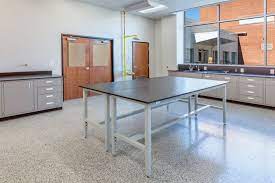Key Provisions of EN 13150:2020
1. Ergonomics and Design
One of the primary focuses of EN 13150:2020 is the ergonomic design of workbenches. Educational laboratories often cater to diverse activities, from experiments to lectures, and the design must accommodate these varying needs. The standard lays out guidelines for appropriate height, width, and depth of the workbenches, promoting user comfort and reducing the risk of musculoskeletal issues.
2. Workbench Material and Construction
EN 13150:2020 emphasizes the importance of using high-quality materials that can withstand the rigors of daily use in educational laboratories. Workbenches must be constructed to be robust, stable, and durable, ensuring a safe and secure environment for students and educators alike.
3. Safety and Environmental Considerations
The safety of students and laboratory personnel is a paramount concern. The standard includes provisions for electrical safety, fire resistance, and chemical resistance, ensuring that workbenches are equipped to handle potential hazards in an educational setting. Additionally, the standard encourages the use of environmentally friendly materials and processes, promoting sustainability in laboratory operations.
4. Storage and Organization
Efficient storage and organization are crucial for maintaining a clutter-free and productive workspace. EN 13150:2020 provides guidelines for incorporating storage solutions into workbenches, enabling easy access to tools, equipment, and materials while maintaining a neat and tidy laboratory environment.
5. Accessibility and Inclusivity
Educational institutions welcome students from diverse backgrounds, and accessibility is a top priority. The standard addresses the need for adjustable workbenches that can accommodate individuals with varying physical abilities, ensuring that all students can actively participate in laboratory activities.
Implications for Educational Institutions
Adhering to EN 13150:2020 offers numerous benefits for educational institutions:
1. Enhanced Safety and Well-being
By following the safety guidelines and ergonomic recommendations of the standard, educational institutions create a safer and healthier environment for both students and faculty. Reduced risks of accidents and injuries contribute to a more positive learning experience.
2. Improved Efficiency and Productivity
The thoughtful design and organization of workbenches streamline laboratory activities, optimizing the use of resources and time. This enhanced efficiency translates to increased productivity, allowing for more extensive experimentation and research.
3. Compliance with Regulatory Requirements
EN 13150:2020 is a recognized standard within the European Union, and compliance demonstrates an institution’s commitment to meeting industry best practices and legal requirements. This adherence to standards enhances an institution’s reputation and credibility.
4. Long-Term Cost Savings
Investing in high-quality, durable workbenches may have an upfront cost, but it pays off in the long run. Reduced maintenance and replacement expenses result in significant cost savings over time.
Conclusion
In conclusion, understanding EN 13150:2020 and its requirements for workbenches in educational laboratories is essential for creating a safe, efficient, and inclusive learning environment. By adhering to the standard’s guidelines, educational institutions can enhance safety, productivity, and compliance while promoting sustainable practices. At [Your Company/Website Name], we are committed to providing you with the most comprehensive information about EN 13150:2020 and other relevant standards. If you have any questions or need further assistance, do not hesitate to reach out to our team of experts.








